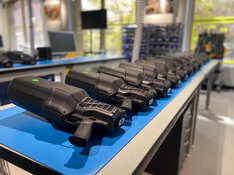DroneShield Ltd. (DRO:ASX; DRSHF:OTC) has announced the publication of a new white paper titled Best Practices for Counter-Drone Deployment at Civil Airports, part of a broader effort to address the growing threat of drones to civil aviation. The white paper was released alongside a strategic partnership with SRI Group, an aviation security and technology advisory firm led by former U.S. Transportation Security Administration (TSA) Deputy Administrator John Halinski. According to DroneShield, the initiative aims to guide airport operators and regulatory bodies in implementing practical, technology-driven frameworks to counter drone-related disruptions.
SRI Group will support the initiative by providing airport operators with vendor-neutral Counter-Unmanned Aircraft Systems (C-UAS) Threat and Risk Assessments. The assessments are designed to identify vulnerabilities, guide mitigation strategies, and offer independent insights that inform procurement decisions. In September 2025, Copenhagen Airport, the busiest aviation hub in Scandinavia, was forced to shut down for nearly four hours due to unauthorized drone activity. The incident caused 77 flight cancellations and 217 delays, underscoring the urgency of airport drone threat mitigation.
"This is about more than technology, it's about leadership," said DroneShield CEO Oleg Vornik in the announcement. Halinski added that DroneShield's efforts "show a real commitment to the safety of airports and the passengers they serve." The partnership will also be on display at the upcoming Airports Council World Annual Assembly in Canada, where airport executives can begin the drone threat assessment process and receive tailored recommendations from SRI Group.
In a separate development, DroneShield received the 2025 Platinum Innovators Award from Military and Aerospace Electronics for its Radio Frequency Artificial Intelligence (RFAI) capability. The award follows the company's 2024 win for its Immediate Response Kit (IRK), marking two consecutive years of top-tier recognition. RFAI is a core component of DroneShield's suite of software-defined systems, using advanced artificial intelligence to convert raw radio frequency data into actionable intelligence. The system's adaptability enables ongoing improvements through AI model training.
DroneShield has also reported significant operational milestones for the third quarter of 2025. Quarterly revenue reached AU$92.9 million, marking a 1,091% year-over-year increase, with cash receipts totaling AU$77.4 million. Year-to-date secured revenues have reached AU$193.1 million, compared to AU$57.5 million for all of 2024.
Security Pressures Drive Growth in Counter‑Drone Detection
According to a 2024 report from Markets and Markets, the Global Drone Detection Market was valued at US$659.4 million in 2024 and was described as the "initial layer of airspace defense in counter UAS operations," enabling operators to identify unauthorized drones, classify intent, and initiate timely responses. The report stated that military and defense organizations accounted for "nearly 79% of the global Drone Detection Market in 2024," with government and law enforcement agencies representing 14% and critical infrastructure operators contributing around 7%. North America held a 55% share driven by defense investments and regulatory initiatives, while Europe followed with 22%, emphasizing civil integration of counter‑UAS technologies.
The same report noted that airports, border zones, and major infrastructure were increasingly integrating anti‑drone systems due to unauthorized incursions. It also stated that drone detection ecosystems incorporated "radar, radio frequency sensors, electro-optical and infrared cameras, acoustic arrays, and artificial intelligence analytics" to enhance situational awareness. Markets and Markets added that system providers were focusing on "enhancing detection accuracy, minimizing false alarms, and optimizing system interoperability" as part of sector competition.
On November 3, Bell Potter Securities reiterated its Buy rating on DroneShield and maintained a 12-month price target of AU$5.30 per share.
Officials said the effort "strengthen[ed] the Indian Army's response capability against evolving aerial threats" and allowed experimentation with indigenous technologies. The Defense Ministry stated that the exercise validated preparedness for next‑generation warfare by integrating aerial and ground assets and testing multi‑domain command and control.
Concerns around elevated security environments continued through global reporting. On November 3, The U.S. Sun detailed how unidentified drones were observed twice in 24 hours above the Kleine‑Brogel air base in Belgium. Belgian Defense Minister Theo Francken said the flights were "not a typical overflight, but a clear mission targeting Kleine Brogel," and he urged additional counter‑UAS resources after jammer responses "proved ineffective." He explained that security forces increased vigilance as the incidents involved "larger drones flying at higher altitudes" over a strategically sensitive location. The reporting referenced multiple recent drone‑related disruptions affecting European airports and military installations.
Analyst Endorsements Support Long-Term Value Proposition
On October 1, Shaw and Partners reiterated its Buy rating on DroneShield, emphasizing the company's position at the forefront of AI-powered counter-drone technology. Analyst Abraham Akra highlighted the DroneSentry platform as "best in class," citing its integration of artificial intelligence to reduce operator burden and accelerate detection times. He noted that the combination of passive radio frequency (RF) sensing and AI enables scalable, cost-efficient systems, particularly well-suited for mobile applications.
Akra also drew attention to DroneShield's strategic fit with regional defense initiatives, including a proposed multi-country "drone wall" in Eastern Europe. He identified the company as a leading contender to supply technology for such programs as they continue to take shape.
On November 3, Bell Potter Securities reiterated its Buy rating on DroneShield and maintained a 12-month price target of AU$5.30 per share. The report, authored by analyst Baxter Kirk, projected a total expected return of 38.4% and highlighted several key drivers of confidence in the company's outlook.
According to Bell Potter, DroneShield had secured a US$25.3 million contract from a defense customer in Latin America. Kirk wrote that before this contract signing, the firm's CY25 revenue forecasts of US$200 million were "97% secured."
Kirk emphasized DroneShield's technological advantage, stating, "We believe DRO has the market-leading counter-drone offering and a strengthening competitive advantage owing to its years of experience and large R&D team, focused on detection and defeat capabilities." He also noted the broader industry context, pointing out that 2026 could represent "an inflection point for the global counter-drone industry" as governments allocate increased funding for soft-kill solutions.
The report referenced the company's active sales pipeline of US$2.55 billion and the expectation that "material contracts" could result over the following three to six months. Bell Potter's valuation was based on a blended discounted cash flow model, combining both base and bull case scenarios. The target price of AU$5.30 represented a 19% upside to the share price at the time of publication.
Expanding Threats, Expanding Opportunity
DroneShield is positioning itself as a first responder to the rising operational risks posed by drone incursions in civil aviation, as outlined in its October 2025 Investor Presentation. The newly launched SentryCiv product, offered as a subscription-only solution for civilian infrastructure such as airports, plays a central role in the company's strategy to expand its presence in non-military markets. SentryCiv was designed to be cashflow positive from the outset, and management expects the civilian segment to account for up to 50% of overall revenue within five years.
Software-as-a-service (SaaS) is becoming increasingly important to DroneShield's business model, with third-quarter SaaS revenues growing by 400% year-over-year. The company aims to integrate multiple SaaS modules into its deployed hardware, including products like DroneSentry-C2 and DroneOptID. This shift is supported by growing demand from government and infrastructure clients for modular, software-driven counter-UAS systems that can evolve alongside the threat landscape.
From a strategic standpoint, DroneShield continues to build out its global manufacturing footprint. A new 3,000-square-meter production facility in Sydney is being established, with European and U.S. facilities expected to follow in 2026. These expansions are aimed at increasing annual production capacity from the current US$500 million equivalent to US$2.4 billion by the end of 2026.
 Streetwise Ownership Overview*
Streetwise Ownership Overview*
DroneShield Ltd. (DRO:ASX; DRSHF:OTC)
The company's AU$2.55 billion pipeline includes more than 300 potential projects across geographies and customer types, including 307 expected to materialize in 2025 and 2026. With the release of its latest white paper, strategic partnerships, SaaS-driven offerings, and recent recognition for technical innovation, DroneShield appears to be consolidating its position as a go-to integrator and thought leader in counter-drone strategy.
Ownership and Share Structure1
Recent filings reveal that Vanguard Group has become a substantial shareholder in DroneShield, holding a 5.45% stake, Fidelity Management and Research holds approximately 7.49% and State Street Corporation holds approximately 5.35%.
Management and insiders hold 1.30%, according to the company.
DroneShield has 905.97 million outstanding shares and 863.8M free float traded shares. Its market cap is AU$3B. Its 52-week range is AU$0.58–AU$6.70 per share.
| Want to be the first to know about interesting Robotics and Technology investment ideas? Sign up to receive the FREE Streetwise Reports' newsletter. | Subscribe |
Important Disclosures:
- As of the date of this article, officers and/or employees of Streetwise Reports LLC (including members of their household) own securities of Droneshield.
- James Guttman wrote this article for Streetwise Reports LLC and provides services to Streetwise Reports as an employee.
- This article does not constitute investment advice and is not a solicitation for any investment. Streetwise Reports does not render general or specific investment advice and the information on Streetwise Reports should not be considered a recommendation to buy or sell any security. Each reader is encouraged to consult with his or her personal financial adviser and perform their own comprehensive investment research. By opening this page, each reader accepts and agrees to Streetwise Reports' terms of use and full legal disclaimer. Streetwise Reports does not endorse or recommend the business, products, services or securities of any company.
For additional disclosures, please click here.
1. Ownership and Share Structure Information
The information listed above was updated on the date this article was published and was compiled from information from the company and various other data providers.













































